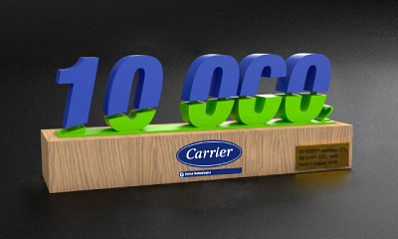

Carrier Commercial Refrigeration celebrated a landmark achievement when it delivered its 10,000th carbon dioxide (CO2) mechanical system to customers in Europe. This is a significant achievement for the Carrier, Profroid, Green & Cool and Celsior brands operating under Carrier Commercial Refrigeration, as they are the first European manufacturer to reach this major milestone.
Carrier Commercial Refrigeration is a pioneer in the use of the natural refrigerant, CO2, for commercial refrigeration applications including cabinets and racks. Also known as R744, CO2 is a non-flammable and non-ozone depleting refrigerant and has a Global Warming Potential (GWP) of just one, which is thousands of times lower than many traditional refrigerants. It is not affected by the latest F-Gas regulation.
The first Carrier CO2 system was installed in 2004 in a supermarket in Switzerland. CO2 mechanical systems continued to gain traction over the next several years with the introduction of the CO2OLtec® range. The commitment to natural refrigerant systems was reinforced in 2010 when Green & Cool – a specialist in high technology CO2 racks – became part of the business.
“We believe that CO2 as a natural refrigerant is the appropriate solution to both the regulation requirements and customers’ expectations for a sustainable and efficient refrigeration solution,” said Victor Calvo, president, Carrier Commercial Refrigeration.
Carrier continues to focus on developing energy efficient systems. The latest CO2OLtec Evo system uses patented ejector technology that can increase energy savings by 30 per cent on an annual basis. And this applies in both cold and warm climates, overcoming challenges across Europe where average temperatures exceed 15 degrees Celsius.
Carrier offers a complete range of CO2 systems to accommodate a variety of applications (from 1 kilowatt to 1.2 Megawatts) in all climates. The movement toward natural refrigerants began with supermarkets installations and is expanding from small stores to sports venues, ice skating rinks and warehouses and beyond.





















